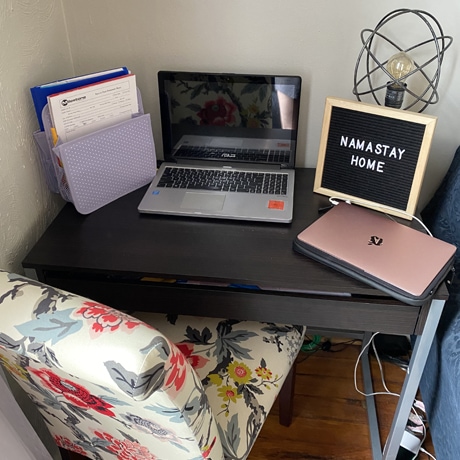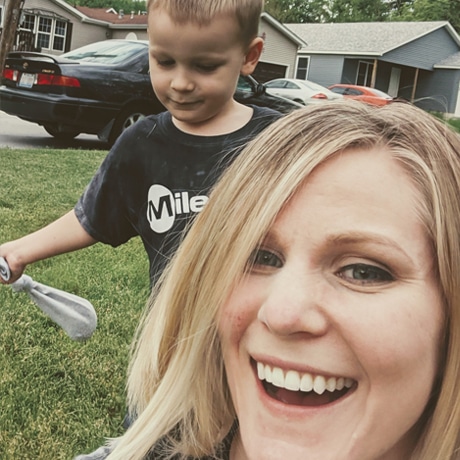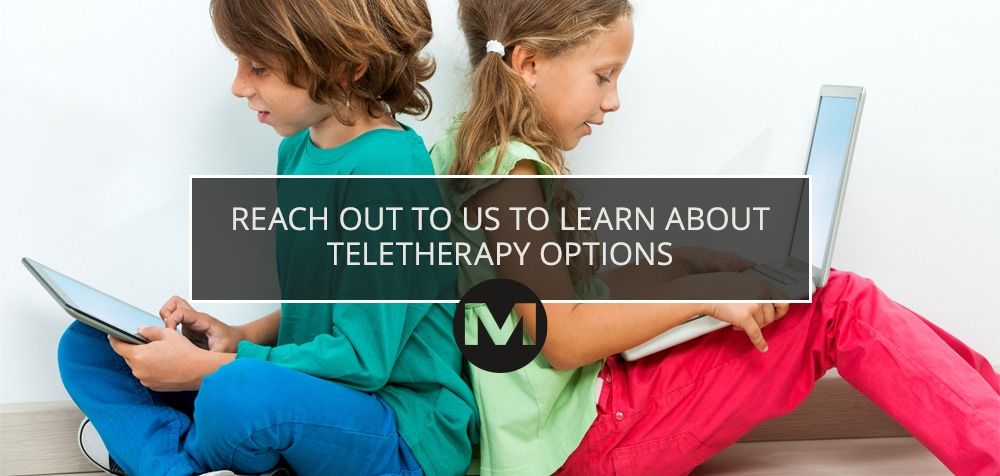Teletherapy Q&A: We offer answers to your questions
Over the past few months, we’ve received a number of questions about the best ways to perform teletherapy. We asked our therapists how teletherapy has been going with the families they treat and for some tips and strategies to make teletherapy even more beneficial for their patients. Here is what they had to say.
What is the best technology (laptop, phone, computer) and platform (Google Hangouts®, Doxy.me®, Zoom® or other HIPAA compliant tools) for holding virtual sessions?
The majority of our therapists say they prefer to use a laptop when performing teletherapy sessions. With laptops, parents can be hands-on with the therapeutic activities. Laptops also allow therapists to share remote options so kids can take control of the therapist’s screen to perform interactive activities on the computer.
You can be rest assured your teletherapy session is HIPPA compliant. All platforms used follow HIPPA guidelines and therapists wear headphones to protect your privacy if anyone could otherwise hear the session. Most of our therapists prefer Google Meet® or Google Hangouts since it integrates well with our accounts. Zoom is another commonly used platform preferred by many therapists and the schools for its easy screen sharing options and good video quality. Along with Zoom, many therapists find it helpful to use their phone so they can gain a better view of activities that are difficult to show by angling the laptop screen down. Giving control of the therapist’s screen to the patient for certain activities remains a challenge, however, all these platforms and the ways we use them are constantly improving, allowing us to provide the best care for Milestone patients.
What items or tools will the family need to best prepare before sessions begin?
The items and tools each family needs is dependent on the patient’s age, discipline and therapeutic activities. Therapists will discuss what their families need to prepare for each session and will also ask for an update to see how things went. Families are asked to:
- Make sure their internet connection and platform are working
- Hold therapy in quiet a space
- Have all materials needed for the session.

In many instances, therapists include siblings or other household members in therapy (as long as they are not a distraction). Family involvement can increase the child’s participation and follow-through as more caregivers are aware of how to help.
Occupational therapists recommend having items like paper, crayons/markers, scissors, glue, beads, pipe cleaners, pompoms, puzzles, cans (to use for weights), clothespins, playdough and a variety of other sensory materials available for teletherapy sessions. Physical therapists recommend having tape, a ball and a stool as well as a baby doll to demonstrate techniques for the families. Our therapists will contact families prior to the session if they are recommending any additional materials beyond those that are typically used.
How can parents prepare their child to maximize engagement in the session?
Many of our therapists recommend layered strategies to help families prepare their children for teletherapy sessions. These strategies vary depending on the child and their specific needs. A good place to start is by minimizing distractions in the surrounding environment to help the child focus on the task at hand.
Some therapists recommend reminding the child earlier in the day that the session is approaching or using timers or visual schedules as needed. They may also request parents remove any technology, such as tablets and phones, in order to improve the child’s communication with the therapist. For children who find adjusting to change difficult, therapists recommend transitioning strategies to ease the moving into their session. One common strategy is to start with an enjoyable and less challenging activity to help gain the child’s interest. Another recommended strategy is to have families provide deep pressure input (heavy work or weighted objects) prior to the session to help regulate the child’s body and sensory system and prepare them for the work to come.
Our therapists recommend families plan their daily routine around the session to get the most out of it. For example, plan around nap time, meals or the transition between caregivers at home.

It may be helpful to incorporate a favorite snack during the session to improve the child’s motivation and pair therapy time with positive reinforcement. On the flip side, avoid denying access to a child’s favorite activity prior to a session. Many therapists recommend that families have toys accessible, especially if the child is younger, to simulate some of the activities and routines that the therapist would perform if they were able to come into the family’s home.
Although our therapists are able to provide a number of recommendations to parents on what to do prior to the session, it may take a few sessions to figure out what works best for each individual child and family.
What is the best setup for the camera to see the client in the frame?
The best setup for the camera to see the client in the frame is dependent on the discipline and activities being performed. For tabletop activities, most therapists find it best to have the computer or tablet in front of the child, at least two to three feet away, so they can see the child. If the family is using a laptop, therapists find it best if the computer is slightly above the child, angled downward, in order to see what the child is doing. For older patients who are able to sit still for longer periods of time, it can be easier to set up the laptop frame. It is important that the family and, in some instances, the child knows where the camera is on their electronic device, so they can move the device to provide the best picture.
For disciplines or activities that involve the child moving around a table, it is helpful for the parent to hold a phone to track the child’s movements around the room. Younger mobile children often leave the video frame when things are broadcast from a static laptop camera. Set the device up a little farther away and out of reach to provide a broader view for the therapist. When therapists are providing supervision, they may ask that your electronic device is set up high with the entire room in view so they can observe the child in whatever activity they are doing without distraction. Lighting also affects viewing quality so families should check their lighting ahead of time and reduce backlighting as much as possible. For instance, if the child is seated with their back to a window, the electronic device adjusts the lighting making the picture dark and hard for the therapist to see what the child is doing. It is always best if the window or lighting is behind the camera or computer.
What are some strategies to keep the client at the computer and actively engaged during sessions?
The ability to keep a child actively engaged at the computer during a session is definitely one of the more challenging aspects of teletherapy for both parents and therapists. One way that therapists maintain their patient’s attention is to switch back and forth between more challenging tasks and sensory activities or movement breaks that the child prefers (for instance dancing, playing an interactive educational game, doing a short scavenger hunt, playing with sensory bins or watching videos). Giving the child breaks and opportunities to be active can help improve participation. This strategy can be implemented intermittently throughout the session.

Other activities like interacting with the patient/family, completing activities with the patient and playing a game while keeping score helps to improve the child’s participation.
Therapists must be able to quickly switch activities (which includes having a number of back-up activities ready) when the child starts to lose interest. Many therapists find that maintaining a discussion with the parent and child and providing advanced notice of what materials will be needed helps minimize the transition time between activities to improve the patient’s overall attention. The use of visuals, schedules and first-then language can help maintain the child’s attention during transitions. Access to fidgets or a preferred snack may benefit children’s attention to task as well. Although our therapists provide these and other recommendation to improve participation during the session, it may take time to determine what works best for each individual patient and their family.
What is the best way for parents to follow through with a HEP?
There are numerous ways to improve follow through with a patient’s home exercise program (HEP), but what works best for each family differs. Some therapists have the family write each activity on a separate Post-it® Note where it can be placed in high-traffic areas of the house as a reminder to complete their HEP. Others prefer to email families their child’s HEP activities and follow up at the start of the following session to see how everything went. Ultimately the therapist wants to be able to provide recommendations for things that may or may not have worked well. It can be helpful to ask parents to share videos of their child completing the activities to ensure compliance with the home exercise program.
Many find it useful to write down the strategies their therapist recommends so they can implement those strategies throughout the week. It is important to make an activity part of the child’s routine in order for meaningful changes to occur. Some therapists put a strong emphasis on regularly performing the child’s HEP, discussing it throughout the entire session while others create weekly checklists to assist families in tracking their HEP compliance.
Are there any other caregivers or individuals involved in the child’s life that would benefit from being involved in a virtual session? What is the best way to involve other caregivers during teletherapy?
One of the best things we’ve discovered during this time of isolation is that teletherapy facilitates increased parent/caregiver engagement — especially for patients that are seen in the school and daycare settings where direct family involvement doesn’t occur as frequently. Teletherapy also allows tangential family involvement when someone is unable to be physically present. The effectiveness of involving other family members or siblings can be dependent on the child. If the sibling is able to participate, they may help improve the child’s participation.
While having everyone involved in the child’s life participate is always encouraged, we need to be mindful that having too many people at once can be overwhelming. Families may benefit by establishing a schedule or system where caregivers take turns assisting the child for each session. Another option is to have caregivers observe the session with their camera off. Our therapists will set aside time during the so caregivers can ask questions, provide input and watch strategies being implemented.
What strategies can caregivers use to assist therapists as they are coaching during the teletherapy session?
Prior to the Covid-19 shutdown, family and caregivers were simply the most important part of every session. And their involvement is more important now than ever. Families can help improve the effectiveness of a session by being present and active, keeping the child engaged, remaining calm, being hands-on, modeling behaviors and providing positive reinforcement. Families can assist by following therapists’ directions on proper hand placement and positioning and asking for clarification when needed to properly execute home exercise plans. Parents and caregivers are experts on their child, so suggestions are always welcome. Parents and caregivers are encouraged to ask therapists questions and express any concerns. This helps therapists adjust sessions or HEP’s to ensure they are providing family and client-centered care. Some therapists find it is helpful to have families write down their questions and/or concerns prior to the session to help guide the treatment session.
Please note that families must always be open, honest and authentic with their therapist. Teletherapy provides a unique experience for therapists to see the child and family in the natural home setting and provide recommendations based on their observations. It is okay for families to discipline or take a time out if needed. The therapist is able to observe these interactions and provide potential strategies to families that may seek assistance. The use of teletherapy services has helped therapists connect and improve relationships with families to better understand their goals and concerns. Families have taken on a lot of responsibility in their child’s therapy and education, which we understand can be frustrating at times, especially with all the other duties that have been added on the home front. However, never forget that there is another side of the coin — and it is vitally important for families to share in the child’s successes, big and small, because they’re the ultimate reason behind the progress!
We hope you’ve enjoyed this Q&A about telehealth and have a bit more knowledge under your belt. For more helpful information, check out these related blog posts: Introduction to Teletherapy and Navigating Teletherapy. We look forward to seeing you back here soon!

